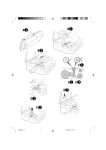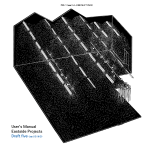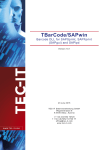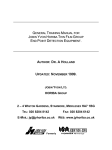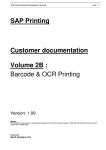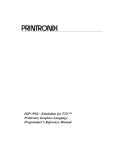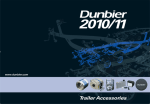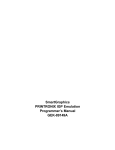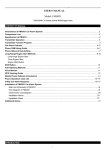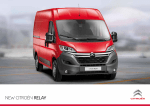Download Vehicle User's Guide 2
Transcript
Guidance Contact: Forestry Commission Mechanical Engineering Services Lomond Court Castle Business Park Stirling FK9 4TU Tel: 01786 435600 Fax: 01786 435601 Web: www.forestry.gov.uk/mes If you need this publication in an alternative format, for example in large print or in another language, please contact: The Diversity Team Forestry Commission Silvan House 231 Corstorphine Road Edinburgh EH12 7AT Email: [email protected] Published by Forestry Commission Mechanical Engineering Services © Crown copyright 2009 All photographs by Forestry Commission Picture Library unless otherwise stated. Designed by Melville Design Associates April 2009 – PP 1K Guidance Vehicle Users’ Guide Introduction This vehicle users’ guide will help you get the most from your new vehicle supplied by Mechanical Engineering Services (MES), and should help you throughout the entire contract period. The guide also covers vital subject areas such as speed limits, towing weights and parts of the Highway Code that you need to be aware of. MES is committed to providing you with a first class service as well as a first class vehicle. We hope you find the guide useful. Glossary of Terms MES TME OME DERV CUR Mechanical Engineering Services Territorial Mechanical Engineer Operational Mechanical Engineer Diesel Engine Road Vehicle Construction & Use Regulations 2 I Vehicle Users’ Guide Index Workshop telephone numbers Emergency telephone numbers Breakdowns Basic details Vehicles you can drive Tyres, batteries and exhausts Weights Repairs and service Vehicle/driver’s log Putting fuel in your vehicle Driving techniques Driving licence Speed limits and limiters Traffic violations Safety Accidents Care of your vehicle Security Returning your vehicle Towing Carrying fuel Overseas travel – CAPES vehicles Other services Accident checklist Accident reporting Occasional driver’s log Workshop locations 4 6 7 8 9 12 13 14 16 18 19 21 23 27 29 30 33 36 38 40 43 44 45 46 48 49 51 Vehicle Users’ Guide I 3 Workshop telephone numbers Workshop telephone numbers Scotland England Aberfoyle Workshop Aberfoyle, Stirlingshire, FK9 3UX 01877 382344 Bellingham Workshop Bellingham, Hexham NE48 2HP 01434 220413 01387 860468 Dalby Workshop Lower Dalby, Pickering, North Yorkshire YO18 7LT 01751 460366 01343 820499 Exeter Workshop Bullers Hill, Kennford, Exeter EX6 7XR 01392 833414 Lakes Workshop Grizedale, Ambleside, Cumbria LA22 0QS 01229 860415 01236 762847 Lyndhurst Workshop 111 High Street, Lyndhurst SO43 7BH 02380 282442 Creebridge Workshop Creebridge, Wigton Stewart, Wigtonshire, DG8 6AJ 01671 403285 Santon Downham Workshop Santon Downham, Brandon, Suffolk IP27 0TJ 01842 810312 Glenbranter Garage Glenbranter, by Dunoon, Argyll, PA27 8DJ 01369 860230 Wales Inver Workshop Dunkeld, Perthshire, PH8 0JR 01350 727483 Chirk Workshop Black Park, Chirk, Wrexham LL14 5BA 01691 773463/772573 Longman Workshop 34 Harbour Road, Inverness, IV1 1UE 01463 232045 Crychan Workshop Tirabed, Llangammarch, Powys, LD4 4DS 01591 601468/610210 Torlundy Workshop Fort William, Inverness-shire, PH33 6SW 01397 705757 TME Ae Garage Ae Village, Parkgate, Dumfries, DG1 1QB Balnacoul Workshop Fochabers, Morayshire, IV32 7PE Cairnbaan Workshop Lochgilphead, Argyll, PA31 8SQ Chapelhall Workshop Chapelhall, Lanarkshire, ML6 8RN 4 I Vehicle Users’ Guide 01546 602165/603411 TME Scotland John Turnbull, 55 Moffat Road, Dumfries, DG1 1NP 01387 266014 TME England/Wales Bruce Cochrane, Powells Place, Welshpool, SY21 7JY 01938 557403 Vehicle Users’ Guide I 5 Emergency telephone numbers Breakdowns Telephone the Following Numbers Accident/Breakdown recovery or Roadside Assistance. Contact: If you breakdown out of hours or you cannot contact the workshop, call the emergency number on the card on page 4 of this guide. Warranty on this vehicle, registration mark: expires: You will need the following information: • nature of the defect • make of vehicle • registration number • FC number • mileage • number of passengers Fire, Police or Ambulance: 999 For service or accident repairs, contact your local workshop. For enquiries about supply of fuel, fuel cards (agency), contract/lease, change or transfer of vehicle contact your OME or TME. 6 I Vehicle Users’ Guide Windscreen breakages If you have a broken or damaged windscreen you should contact your local workshop. Most workshops use a firm called Auto Windscreens, who operate a 24-hour mobile nationwide repair and replacement service and can be called free on 0800 919 700. In many instances, a laminated glass repair is a cost effective alternative to windscreen replacement and is carried out to the British Standard AU242. Vehicle Users’ Guide I 7 Basic details Vehicles you can drive General The following tables list the vehicle category descriptions for driving tests passed after 1 January 1997 and the minimum ages for driving them. All weights refer to maximum authorised mass (MAM) unless stated otherwise. This is the total weight of the vehicle plus the maximum load it can carry. Vehicle Type: FC Number: Registration Number: Date of First MOT: Cars with and without trailers Driving Licence Category (Vehicle only): Motor vehicles with a MAM not exceeding 3500kg having not more than eight passenger seats with a trailer up to 750kg. Combinations of towing vehicles in category B and a trailer, where the MAM of the combination does not exceed 3500kg and the MAM of the trailer does not exceed the unladen mass of the towing vehicle B 17* As cars, but with automatic transmission B 17* Combinations of vehicles consisting of a vehicle in category B and a trailer, where the combination does not come within category B B 17 Vehicle plus Trailer: Tyres Tyre type and size: Tyre pressure/normal use: Front : Rear: Tyre pressure/fully laden: Front: Rear: Service Service interval: Weight miles or months Category Min age *Age 16 if you are currently getting Disability Living Allowance at the higher rate (mobility component) Gross vehicle weight: Gross train weight: Nominated MES Workshop: Telephone: 8 I Vehicle Users’ Guide Vehicle Users’ Guide I 9 Vehicles you can drive Vehicles you can drive Medium sized vehicles with or without trailers Category Min age Minibuses with or without trailers Vehicles between 3500kg and 7500kg with a trailer up to 750kg C1 18 Vehicles with between nine and sixteen passenger seats with a trailer up to 750kg Combinations of vehicles where the towing vehicle is in subcategory C1 and its trailer has a MAM of over 750kg provided that the MAM of the combination thus formed does not exceed 12000kg and the MAM of the trailer does not exceed the unladen mass of the towing vehicle. (If you passed your category B test prior to 1.1.1997 you will be restricted to a total weight not more than 8250kg) C1+E 21* Combinations of vehicles where the towing vehicle is in subcategory D1 and its trailer has a MAM of over 750kg, provided that the MAM of the combination thus formed does not exceed 12000kg, and the MAM of the trailer does not exceed the unladen mass of the towing vehicle *Age 18 if combination weight is under 7500kg Large vehicles with or without trailers Category Min age Vehicles over 3500kg with a trailer up to 750kg C 21* Vehicles over 3500kg with a trailer over 750kg C+E 21* D1 21* D1+E 21* *Age 17 if member of the armed forces *Age 18 while learning to drive or taking a passenger carrying vehicle (PCV) test; or not engaged in the carriage of passengers; or after passing a PCV test when: • driving on a regular service where the route does not exceed 50km • driving a PCV constructed to carry no more than 16 passengers • the vehicle is operated under a public service (PSV) operator’s licence or permit. *Age 17 if member of armed forces *Age 18 if member of the young drivers scheme 10 I Vehicle Users’ Guide Vehicle Users’ Guide I 11 Tyres, batteries and exhausts Tyres Ensure you know the correct tyre pressure for the vehicle. Correct tyre pressures are important as low pressure will increase fuel consumption and emissions. The legal minimum tread depth for tyres in the UK and throughout the European Community is 1.6mm throughout a continuous band comprising the centre three-quarters of the breadth of tread and around the entire outer circumference of the tyre. It is your responsibility to ensure that the tyres are replaced before they reach this state, probably at about 2mm. If you need to replace a tyre, you should first contact your local workshop for authorisation and they will advise on the method of replacement – either through them, an independent fitter or a mobile replacement service. If you have a puncture you should replace the wheel with the spare if it is safe to do so and you feel you are competent to carry out this task. You should then obtain a replacement, as above, as soon as possible. Weights All vehicles must have either a manufacturer’s plate or a Department of Transport plate which gives maximum permitted axle weights and gross weights for use in the UK. Information on the Gross Vehicle Weight (GVW) and Gross Train Weight (GTW) can be found in the basic details information shown on page 4, or in the vehicle handbook. If in doubt or if you have had additional items added to the vehicle, for example a crane, contact your local workshop who will arrange to get the vehicle weighed. How to calculate weights Payload = Gross Vehicle Weight, less kerb weight and an allowance of 75kg for driver. Gross Vehicle Weight = The total permissible weight of a vehicle, with body, payload, ancillaries, fuel, oil, water, driver and crew. In the event that you cannot replace the wheel with the spare call your local workshop. If this happens outside normal working hours contact the call centre as specified under the Emergency Contact details on page 4. Kerb Weight = The weight of the complete vehicle and all equipment including fuel and water, but without the payload, driver or any crew. All kerb weights quoted are subject to manufacturing tolerances and are for vehicles with minimum equipment. Batteries and exhausts Gross Train Weight = Only applies if you are towing a trailer. The total permissible weight of a vehicle (see GVW) together with its trailer and load. Contact your local workshop and they will advise you of local agreements to replace batteries and exhausts. For out of hours emergencies use the number shown on the card on page 4. 12 I Vehicle Users’ Guide Vehicle Users’ Guide I 13 Repairs and service It is the driver’s responsibility to make sure that this vehicle is roadworthy and that it is serviced according to the manufacturer’s guidelines. The work must be carried out by an MES workshop or, at its discretion, by an MES-approved, sub-contracted garage. You must not take your vehicle to a private garage without authorisation from your workshop. When the vehicle is serviced, ensure that the vehicle service book is stamped by the workshop or garage. Any unauthorised work will be charged to your cost centre. Vehicle servicing details Service Interval basic detail information on page 8. Should your vehicle develop a fault, report it immediately to your MES workshop, who will decide if a repair needs to be done immediately, or whether it can wait until the next service. Giving the workshop this prior notice will allow it to order any necessary spare parts, so that turn-around time for repairs can be minimised. 14 I Vehicle Users’ Guide Repairs and service MOT It is an offence to use a vehicle on public roads without a valid test certificate. The current MOT requirements are: • Cars and light vehicles require their first test three years from the date of first registration and every year thereafter. • Passenger carrying vehicles with more than nine seats including the driver’s seat, and vehicles weighing more than 3500kg, require an annual test one year from first registration and every year thereafter. You MUST NOT drive a vehicle without a valid MOT certificate, when it should have one. The only exception to this is that you may drive to a prearranged test appointment or to a garage for repairs required for the test. Reference: Road Traffic Act 1988 sections 45, 47, 49 and 53. Vehicle Users’ Guide I 15 Vehicle/driver’s log Vehicle/driver’s log Checks Driver’s log As well as servicing and MOT tests, you should regularly check your vehicle to make sure it is fit for purpose. These checks should be noted in the driver’s log as this will help keep tabs on potential problems. You should report all faults to the workshop. We are legally required to be able to identify the drivers of all our vehicles. The regular driver of the vehicle must complete a log similar to the one below. Driver As an aide memoire you should use the following checklist: Check Daily Windscreen washer level X All fluid levels, water, oil, power steering, brake fluid X Signature Date from Date to Weekly Tyre pressures X Condition of windscreen X Condition of body X Condition of wipers X Condition of all tyres (minimum depth 1.6mm) X All drivers, other than the regular driver, must complete the Occasional Driver’s Log. For an example see page 49. Drivers should investigate unusual fluid losses, for example oil or antifreeze. Spills on parking areas could give a good indication that the vehicle has developed a leak. 16 I Vehicle Users’ Guide Vehicle Users’ Guide I 17 Putting fuel in your vehicle Agency cards For most FC vehicles an agency card is the preferred method of payment for fuel. It does however have some obligations and procedures attached to it. If you are a cardholder you need to be aware of the guidelines for use. Note: It is your responsibility to safe guard the fuel card at all times. Keep your fuel card safe – keep it with you at all times. Never leave the fuel card in the vehicle. Bulk fuel Many forest district sites and workshops have bulk fuel installations. This fuel should be used whenever possible, as it can be cheaper than pump prices. This will help us to reduce the total running costs of vehicles. Driving techniques Adopting a smarter driving style is easy. And once you’ve mastered it, not only will you start to make real savings, but you’ll also be doing your bit for the environment. That’s because smarter driving means driving your car more efficiently. Doing this means your car will produce less carbon dioxide (CO2), the main gas contributing to climate change. Remember to follow the steps below and you’ll soon be saving money and reducing your car’s impact on the environment. 1. Check your revs - change up a gear before 2,500rpm (petrol) and 2,000rpm (diesel). 2. Anticipate road conditions and drive smoothly, avoiding sharp acceleration and heavy braking. This saves fuel and reduces accident rates. 3. Use air conditioning sparingly as it significantly increases fuel consumption. Local accounts In certain areas where garages do not accept fuel cards and there is no bulk fuel installation nearby, we have set up local accounts which are settled on a monthly basis. This is clearly the most expensive, and administratively, the most time-consuming method of buying fuel. Your line manager will be able to advise you about local accounts. 18 I Vehicle Users’ Guide Vehicle Users’ Guide I 19 Driving techniques Driving licence 4. The most efficient speed depends upon the car in question but is typically around 45 - 50mph. A faster speed will greatly increase your fuel consumption. You need a valid driving licence to drive FC vehicles. You should ensure that the categories on your licence are appropriate for the vehicle you drive. 5. Drive away immediately when starting from cold - idling to heat the engine wastes fuel and causes rapid engine wear. Minibuses 6. Accessories such as roof racks, bike carriers, and roof boxes significantly affect your car’s aerodynamics and reduce fuel efficiency, so remember to remove them when not in use. 7. Avoid short journeys - a cold engine uses almost twice as much fuel and catalytic converters can take five miles to become effective. 8. Plan your journeys to avoid congestion, road works and getting lost. 9. Check your tyre pressure regularly - under-inflated tyres are dangerous and can increase fuel consumption by up to 3 per cent. 10. If you’re stuck in a jam, switch the engine off if you expect to be there for more than a minute or two. Switching the engine off will save fuel and reduce emissions. Source: Energy Saving Trust further details available at: www.energysavingtrust.org.uk Staff must be specifically authorised to drive a minibus in accordance with OGB22 Driving at Work. Driving licence requirements prior to authorisation are: (a) drivers of minibuses must be over 21; (b) have passed their test before 1 January 1997 and have category D1 entitlement; or (c) hold a PCV licence; (d) drivers who passed their test on or after 1 January 1997. A category B licence allows people to drive vehicles with no more than 8 passenger seats. However, they may still drive a 9-16 passenger seat minibus under a permit provided the following conditions are met:(i) the driver has held the category B licence for at least 2 years; (ii) the driver receives no payment or consideration for driving the vehicle other than out-of-pocket expenses; (iii) the minibus has a gross weight not exceeding 3.5 tonnes (4.25 tonnes including any specialised equipment for the carriage of disabled passengers). (see Mechanical Engineering Legal Bulletin (MELB) 111 for further information on use of Tachographs in minibuses) 20 I Vehicle Users’ Guide Vehicle Users’ Guide I 21 Driving licence Trailers All drivers who passed their test before 1st January 1997 retain their entitlement to tow trailers until their licence expires. This means they are generally entitled to drive a vehicle and trailer combination up to 8.25 tonnes maximum authorised mass (MAM). They are also entitled to drive a minibus with a maximum of 17 seats with a trailer over 750kgs MAM. Any changes to your licence must be notified to your line manager. Individual authorisation to drive on FC business As well as your DVLA licence, you will need your line manager’s authority to drive on FC business in accordance with OGB 22. You do not need to sit another test to drive the majority of vehicles, but for certain types such as four wheel drive vehicles and towing trailers, a training course is advised. Your line manager will check that you have a valid licence and will tell you about your responsibility to maintain and care for the vehicle. MES, when requested, will show drivers how to complete daily and weekly vehicle checks Speed limits and limiters The speed limit on all Forestry Commission roads is 15 mph due to vegetation growth, road design and line of sight on bends. You must not exceed the maximum speed limits for the road and for your vehicle. Streetlights usually mean that there is a 30mph speed limit unless there are signs showing another limit. The speed limit is the absolute maximum and does not mean it is safe to drive at that speed irrespective of conditions. Driving at speeds too fast for the road and traffic conditions can be dangerous and is one of the most common causes of accidents. You should always reduce your speed when: • • the road layout or condition presents hazards, such as bends; • • weather conditions make it safer to do so; and sharing the road with pedestrians and cyclists, particularly children and cyclists; driving at night as it is harder to see other road users. Crown vehicles Forestry Commission vehicles (with the exception of CAPES vehicles) are Crown Vehicles and as such are exempt from Road Tax and are not covered by an insurance policy. The Forestry Commission covers the risk itself under Section 183 of the Road Traffic Act 1988. Note: FC vehicles are only to be used on official business. Private use is not insured and is therefore illegal. 22 I Vehicle Users’ Guide Vehicle Users’ Guide I 23 Speed limits and limiters Speed limits and limiters National speed limits These are the national speed limits and apply to all roads unless signs show otherwise. Paragraph 124 of the Highway Code refers. Built-up areas* Single carriageways Dual carriageways Motorways Goods vehicles between 3.5 and 7.5 tonnes and passenger vehicles with more than 8 seats, irrespective of weight which were first registered after 1 October 2001 must be fitted with a speed limiter (further information on use of limiters in minibuses is available in MELB 111). Limiters must be calibrated and set or adjusted so that the “stabilised speed” does not exceed the limits as set out in the regulations: 1. Mini buses 100kph (62.14mph) Type of vehicle mph (km/h) mph (km/h) mph (km/h) mph (km/h) 2. Goods vehicles 90kph Cars (including car-derived vans up to 2 tonnes maximum laden weight) 30 (48) See MELB 108/2 Speed Limiter Legislation for further details. Cars towing caravans or trailers (including car-derived vans) 30 (48) 50 (80) 60 (96) 60 (96) Buses, coaches and 30 (48) minibuses (not exceeding 12 metres in overall length) 50 (80) 60 (96) 70 (112) Goods vehicles (not exceeding 7.5 tonnes maximum laden weight) 30 (48) 50 (80) 60 (96) 70 (112)** Goods vehicles (exceeding 7.5 tonnes maximum laden weight) 30 (48) 60 (96) 70 (112) 70 (112) (56mph) “Stabilised speed” is the mean speed of a vehicle when its speed is controlled by the limiter and stable control has been achieved. 40 (64) 50 (80) 60 (96) Limiters must be sealed by an authorised sealer in such a way that they cannot be tampered with or the power supply disconnected. Limiters fitted voluntarily to vehicles used before the implementation date, whilst required to be sealed, are not subject to sealing by an authorised sealer, but if a replacement is fitted after that date then the regulations must be complied with. Limiters must be maintained in good and efficient working order. A plate must be displayed in a prominent position in the driving cab, clearly and indelibly marked with the speed limiter setting. * The 30mph limit applies to all traffic on all roads with street lighting unless signs show otherwise. ** 60 if articulated or towing a trailer 24 I Vehicle Users’ Guide Vehicle Users’ Guide I 25 Speed limits and limiters Using the outside lane of a motorway If a vehicle has, or is required to have, a speed limiter fitted and working, then it is not permitted to use the outside lane of a three or more lane motorway. If the vehicle is required to have a speed limiter fitted but it is not working, it will be illegal to use it on the public highway under the Roads Vehicles (Construction and Use) Regulations 1986. Traffic violations Whilst driving an FC vehicle, the law will hold you, as driver, responsible for any offences which may arise, such as speeding, illegal parking and contravention of Construction and Use Regulations. Further details are given in Personnel Memorandum 2, issued on 19 October 2000. You are responsible for ensuring that your vehicle complies with legal requirements in the same way that you would be for you own car. You should regularly check your lights and tyres and get any faults remedied by reporting them to your nominated workshop. If you are asked to produce your driving documents by the Police, you should inform them that a Crown vehicle is exempt from vehicle excise duty, and instead, carries on the windscreen a disc certifying Crown Exemption. You should also point out that the Forestry Commission does not formally insure its vehicles, but carries the risk itself as allowed under Section 183 of the Road Traffic Act 1988. Parking and motoring offences You are personally responsible for any fines resulting from parking and motoring offences and these should be paid within the prescribed time. You must report any traffic offence, endorsement, imposition of penalty points etc to your immediate line manager. Mobile phones You must keep control of your vehicle at all times. It is illegal to use a hand-held mobile phone or microphone when driving. Using hands-free equipment is also likely to distract your attention from the road. It is far safer not to use any telephone while you are driving, so find a safe place to stop first. 26 I Vehicle Users’ Guide Vehicle Users’ Guide I 27 Safety Safety Safety checks Check your vehicle regularly. Remember you are responsible for the roadworthiness of your vehicle. External checks Make sure: • • your mirrors are clean and are working correctly; your windscreen is free from chips or cracks; 3. Listening to the radio can help reduce stress, especially in traffic jams. • • • 4. Try to adopt a positive mental attitude. This helps with the frustration of congestion. • your number plates are free from chips and cracks, and are clearly visible. 5. Don’t try to change other people’s attitude to driving – you can’t, but you can change. Internal checks 6. Try to be courteous and stay calm if provoked by another driver. When seated, make sure: 7. Drive with your car doors locked and if you see trouble, don’t leave the safety of your vehicle. that the seat position is suitable for driving; 8. Count slowly from 1 to 10 if you are tempted to jump out of your vehicle in a fit of rage. • • • • 9. Don’t retaliate by flashing headlights, sounding your horn or making rude gestures. It only makes a volatile situation worse. • that all the relevant warning lights in the dashboard go out when you start your engine. A ten point plan for avoiding road rage 1. Forget work or home worries while you’re behind the wheel and concentrate on your driving. 2. Plan your journey as this helps reduce anxiety and stress. 10. If you are the victim of aggression, take note of the person’s registration number and report the incident to the police as soon as possible. 28 I Vehicle Users’ Guide your windscreen wipers are making complete contact with the screen, and that the rubbers are not cracked or detached from the arm; there is no damage to the bodywork, or loose trim; your tyres have the minimum tread depth, are not unevenly worn and are inflated properly; and you have a full view out of both the rear and side view mirrors; your hand brake and foot brake are working correctly; your seat belts are fully functional and that you are comfortable and not constricted in any way; and REMEMBER YOU ARE PLACING YOURSELF AT RISK IF YOU NEGLECT THESE CHECKS! Vehicle Users’ Guide I 29 Accidents Accidents Careful drivers take care while driving. They take care of themselves, their vehicle, and their load whilst always being aware of the actions of other road users. ‘Safe driving is a mark of a good driver’ Staff Notice 12 covers all aspects of traffic accidents and prosecutions. A copy is available at your cost centre or on the intranet. A comprehensive checklist (C128b) of what you should do if you are involved in an accident is on page 46 of this handbook, however the most important aspects are given below. • avoid making any remarks that might be taken as an admission of responsibility for the accident; • obtain the name(s) and address(es) of other person(s) involved and their insurance details; and • record details of other vehicles involved i.e. registration numbers. These should be entered onto form C128, a copy of which is included in this handbook. Complete form C128a (see example on page 48) showing our HQ Office address and hand it to the other driver(s). You must report the accident to the Police if: • • • • any person is injured; the other party fails to stop at the scene; an animal is injured; or anyone has committed an offence which may have caused or contributed to the accident and property has been damaged. 30 I Vehicle Users’ Guide If you’re involved in an accident, tell your immediate line manager as soon as possible. Once you return to your forest unit or depot you should complete all the details of form C128. This form should be completed for any accident damage to your vehicle whatever the circumstances. Report all accident damage to your local workshop. The workshop manager will arrange to have the vehicle inspected and accident damage assessed. All estimates must be sent to the workshop manager. If you are involved in an accident that causes damage or injury to any other person, vehicle, animal or property, you MUST: • • • stop; switch off all engines; do not smoke; Vehicle Users’ Guide I 31 Accidents Care of your vehicle • • use your hazard warning lights to warn other traffic; Entertainment radio ensure that the accident site is made safe and that approaching drivers are warned of the danger; • arrange for the emergency services to be called immediately and give full details of the accident location and any casualties. On a motorway, use the emergency telephones as these allow the services to locate you quickly. If you use a mobile phone, first make sure you have identified your location from the marker posts on the side of the hard shoulder; Most vehicle radios are protected by a security code and in the event of a flat or disconnected battery the radio will be deactivated. To reactivate the radio, you will need to enter the four-digit security code. For assistance contact your local workshop. • move uninjured people away from the vehicles to safety: on a motorway this should, if possible, be well away from the traffic, the hard shoulder and central reservation; • do not move injured people from their vehicle(s), unless they are in immediate danger from fire or explosion; • extinguish minor fires, a fire extinguisher is fitted to all FC vehicles. Do not attempt to extinguish a fire in the engine compartment, as opening the bonnet will make the fire flare. Call the fire brigade; and • do not remove a motorcyclist’s helmet unless it is essential to do so. If you must remove helmet take great care to support the neck to prevent further injury. Stay at the scene until emergency services arrive. Co-operate fully with the emergency services. 32 I Vehicle Users’ Guide Front air bag The inflatable cushion or ‘air bag’ is a safety device designed to operate in the event of a violent impact. Note: You should not use solvents or cleaning agents to clean the air bag – use a damp cloth instead. Do not apply stickers to the bag. Catalytic converter The catalytic converter is an exhaust component which is very fragile but following the points below will keep it, and you, safe: • keep to the manufacturer’s recommended service intervals as poor performance resulting from irregular servicing could damage the catalytic converter; • if you have difficulty cold starting your vehicle, contact your local workshop; • • allow the engine to return to idle before switching off; and do not park or drive over highly inflammable material (dry grass, inflammable liquids etc.), as the catalytic converter operates at temperatures exceeding 40o centigrade. Vehicle Users’ Guide I 33 Care of your vehicle Care of your vehicle Modifications Report all defects to the workshop You must not alter or modify FC vehicles in any way, shape of form without prior approval from the workshop manager and leasing company. Unapproved modifications will be charged to your cost centre and you may be charged for any remedial works required to return the vehicle to the original specification. Disciplinary action may also be taken against you. Daily and weekly maintenance will help keep your vehicle looking, and working at, its best. You must look after your vehicle and this will include washing the vehicle and cleaning the interior on a regular basis e.g. once a week. You should also clean your vehicle before presenting it for service or repair. Warning Displays Read the manual supplied with your vehicle and make sure that you understand the meaning of all warning displays on the vehicle instrument panel. Do not ignore warning lights. When you turn on the ignition key, warning lights will be illuminated but will go out when the engine starts (except the parking brake warning light). If they do not, or if they come on whilst you are driving, stop and investigate the problem. Check tyre pressures weekly. Do this before your journey, when the tyres are cold. Tyre pressures are set when tyres are cold and warm tyres or hot tyres may give a misleading reading. Never deflate warm tyres to the recommended (cold) pressure. Check the fluid levels in your vehicle at least weekly. Low brake fluid may result in brake failure and an accident. Make sure you recognise the low fluid warning lights. All drivers are encouraged to inspect the vehicle and check all tyres and fluid levels before starting every journey. If the charging warning light comes on while you are driving, it may mean that the battery isn’t charging. This must be checked as soon as possible to avoid loss of power to lights and other electrical systems. 34 I Vehicle Users’ Guide Vehicle Users’ Guide I 35 Security Security Never: • Leave cash, credit cards, cheque book, mobile phones, vehicle documents, fuel cards, laptop computers, memory sticks or other valuables in the car. If you have no choice but to do so, make sure they are hidden well out of sight before you begin your journey - thieves may be watching you park. Remember: Did you know? Half a million vehicles are stolen in the UK every year. Vehicle crime accounts for more than a quarter of all reported crime: • • • • for all a thief knows, carrier bags may contain valuables so ensure they are hidden out of sight to reduce temptation; • always keep your keys safe. Never leave them in the car, even for a second; and • treat them as you would your cash and credit cards. Make sure they are kept in a secure place at home and at work - burglars have been known to break into houses and offices to steal car keys. 40 per cent of stolen vehicles are never returned to their owners; property is stolen from cars every 13 seconds in England & Wales; and Security Devices more than 30 per cent of vehicle crime happens in car parks. If you think the level of risk to your vehicle warrants additional security talk to your line manager. Common car sense Always: • close the windows and sunroof, lock the doors and activate any security devices when leaving your car unattended; and • park with care, particularly at night or if you are leaving the vehicle for a long time. If possible, park in a busy, well-lit area. 36 I Vehicle Users’ Guide Vehicle Users’ Guide I 37 Returning your vehicle When returning your vehicle you must ensure that it is clean inside and out, is serviced and has no significant damage. A fully-completed service book and manufacturer’s handbook must be left with the vehicle. All vehicles must be returned to the nominated workshop, either at the termination of lease, or at the time of taking delivery of a new vehicle. Vehicles will be inspected by the workshop manager and by the leasing company. Returning your vehicle All additional equipment such as towbars, lighting boards, roof racks, roof bars, winches etc must also be returned if originally supplied. Any vehicle returned without all accessories and equipment will result in your cost centre being charged for the losses. Badges and labels The workshop will arrange the removal of all livery from the vehicle. MES has to rectify undue wear and tear. Any costs incurred may be passed on to your cost centre and, if appropriate, disciplinary action may be taken against you. Wear and tear All wheel trims must be present and all original equipment refitted when the vehicle is returned at the end of its leasing period. The cost of rectifying burns, tears, heavily stained areas or excessive wear to the inside of the vehicle and luggage area may be charged to your cost centre. Costs to rectify body damage may also be charged to your cost centre. You must return: • • • • • • • all keys including master keys; spare wheel; jack; wheel brace; parcel shelf; radio equipment etc; and service book. 38 I Vehicle Users’ Guide Vehicle Users’ Guide I 39 Towing You must ensure the tyres on your vehicle or trailer are not over-loaded by keeping them at their correct pressure. Never exceed the vehicle’s Gross Axle Weight Rating (GAWR) or the Gross Vehicle Weight Rating (GVWR). This information can be found on the certification label or in your vehicle owner’s manual. You should also ensure the vehicle load is distributed evenly, so that no individual axle or tyre is overloaded. Speed restrictions When towing a trailer the speed limit remains the same in a built up area but is restricted to 50mph on single carriageway roads, and 60mph on dual carriageways and motorways, provided no lower limit is in force. You are not allowed to use the outside lane on motorways with three or more lanes when towing. If you tow a small trailer without brakes, the weight of the trailer is limited to 50 per cent of the kerb weight of the car or 750kg, whichever is less. When towing larger trailers that have brakes fitted, the laden weight of the trailer should not (as a rule of thumb) exceed 85 per cent of the kerb weight of the vehicle. Details of the manufacturer’s towing capacity can be found on page 8 of this handbook. You must bear in mind the total weight will include passengers and vehicle load, the trailer and any items put in the trailer. Towing You must: • • not tow more than your licence permits you to; • secure your load. not overload your vehicle or trailer. You should not tow a weight greater than that recommended by the manufacturer of your vehicle; and Loading your trailer Many problems associated with towing a trailer are caused by incorrect loading. When loading the trailer, try and put all heavy items over the axle, and make sure they are secured to prevent movement when cornering or braking. Where possible, put heavier items in the vehicle and lighter items in the trailer. Consult your trailer and vehicle handbooks to establish the correct “nose weight” for your trailer. + Ideally the actual laden weight of the trailer should not exceed 85 per cent of the kerbside weight of the vehicle. Sensible Loading: how to proportion it. light items medium items Vehicle Loading – It is your responsibility to ensure that the load is safe. heavy items 40 I Vehicle Users’ Guide = actual laden weight The actual laden weight of the trailer should not exceed the kerbside weight of the vehicle. Vehicle Users’ Guide I 41 Towing Before setting off Make sure the trailer is regularly serviced and maintained. You should not leave a trailer unused for the majority of the year and then take it out on the road without first checking it is roadworthy, in particular brakes, tyres and lights. You should remember that a vehicle and trailer will take longer to stop, accelerate and turn than a vehicle on its own. Carrying fuel Road Traffic Regulations state that highly inflammable fuels may only be carried in approved containers. The following rules apply: • when moving petrol by road you can avoid all requirements of the Carriage of Dangerous Goods and Use of Transportable Pressure Equipment Regulations 2004 (known as ADR) by using a container of no more than 3 litre capacity. On arrival at your destination the petrol must be transferred quickly to the machine or vehicle tank. The ADR exempts private, non-work related carriage of petrol and larger non-approved containers are available for public use but these must not be purchased for official use; • • • all fuel containers must be safely secured; • • avoid spillages and clean up immediately; and As an aide memoire, use the following checklist: • • make sure the trailer is regularly serviced and maintained; • check the tyres are correctly inflated and free from cuts and other defects, for example cracking or perishing; • check the operation and condition of all lights. All lights must be kept clean; • check the operation of brakes and ensure that the wheels turn freely when the brakes are released, i.e. they don’t bind; and • check the condition of the body, headboard, tailgate and all anchorage points. check tyre wear. All tyres must have a tread depth of at least 1.6mm across the central three-quarters of the breadth of the tread and around the entire circumference; 42 I Vehicle Users’ Guide drivers and passengers must not smoke when carrying fuel in containers; do not smoke or carry a visible naked light when dispensing fuel from containers; never use a mobile phone on the forecourt of a petrol station or close to a vehicle carrying flammable loads. If you need to carry larger quantities of fuel refer to Operation Guidance Booklet No. 11 Managing Fuel. Vehicle Users’ Guide I 43 Overseas travel – CAPES vehicles If you want to take your car abroad on either business or pleasure you must apply to the owner in writing not less that one month beforehand for foreign travel documents. Further details are contained in the Driver’s Pack. Before taking the car out of the United Kingdom you must, at personal expense, obtain comprehensive insurance for the countries to be visited, along with continental breakdown and recovery insurance. The lease hire company can usually provide the necessary documents. As Crown Vehicles are exempt from road tax and are not covered by normal insurance (self insured), you cannot take them abroad. Other services Fitting accessories Additional accessories may be fitted to the vehicle but only with the permission of the owner. Cost centres will be responsible for the goods and all associated costs. If these items need to be removed at the end of the lease or the return of the vehicle, any remedial work required to make good any damage will be charged to the cost centre. Replacement vehicle Many of our workshops can provide loan vehicles, subject to demand and availability. If your vehicle is off the road or in for a major repair, MES will do everything possible to give you a replacement vehicle. Before contacting your TME, ask your workshop if a loan vehicle is available. Use of blue flashing lights The Road Vehicles Lighting Regulations 1989 Section 16 permits the use of blue lights on Forestry Commission vehicles for the purpose of fighting fires. Flashing blue lights must not be used on FC vehicles for any other purposes. Amber flashing lights should be used in all other working situations to warn other motorists. 44 I Vehicle Users’ Guide Vehicle Users’ Guide I 45 Accident checklist Traffic accidents/Form C128b (Revd. 03/02) If you are involved in a traffic accident while driving an FC vehicle or a hire car on official business complete the following checklist. 1. Complete C128a and hand it to other driver. 2. Under no circumstances make any remarks which could be taken as an admission of liability. 3. Get the full name and address of the other driver and details of their vehicle. Accident checklist 11. Get written statements from any FC people who witnessed the accident. 12 Pass the completed traffic accident report, sketch and any statements from FC people to your line manager. Ensure that a copy of the accident report etc is sent to MES Head Office, Lomond Court, Stirling within 7 days of the accident. 13. Do you need to report the incident as a dangerous occurrence in accordance with section 4 of OGB 23. If so complete form C49 (also see para 8 of PM2 revised 3/02). 4. Get full details about the other driver’s insurance including the name and address of their insurance company, policy number and whether they have comprehensive or third party insurance. 5. Advise the police in the following circumstances: a. when anyone is hurt. b. when the names and addresses of the parties involved are not exchanged at the time of the accident. c. when in your opinion the other party has committed an offence which has caused or contributed to the accident. 6. If the accident is serious or if there is likely to be any dispute about liability, try to get both vehicles photographed at the scene before they are moved. 7. Get the full names and addresses of any witnesses to the accident. 8. Advise your line manager as soon as possible. 9. Complete a traffic accident report (C128) as soon as possible while the details of the accident are fresh in your mind. 10. Complete a sketch showing full details of the accident. 46 I Vehicle Users’ Guide Vehicle Users’ Guide I 47 Accident reporting Any communication regarding the traffic accident on involving Forestry Commission vehicle registration number All drivers, other than the regular driver, must complete this log when using this vehicle. Driver’s signature Forestry Commission Lomond Court Castle Business Park Stirling FK9 4TU Occasional driver’s log on official business from statutory insurance requirements. As such the Forestry Commission bears its own insurance. Signed: Address: E L P M A EX Date This form can be downloaded from the Mechanical Engineering Services site on the intranet Start time Section 183 of the Road Traffic Act 1988 grants exemption to Crown vehicles Finish time Name of driver should be addressed to Forestry Commission at the above address. 48 I Vehicle Users’ Guide Vehicle Users’ Guide I 49 Notes/comments 50 I Vehicle Users’ Guide


























